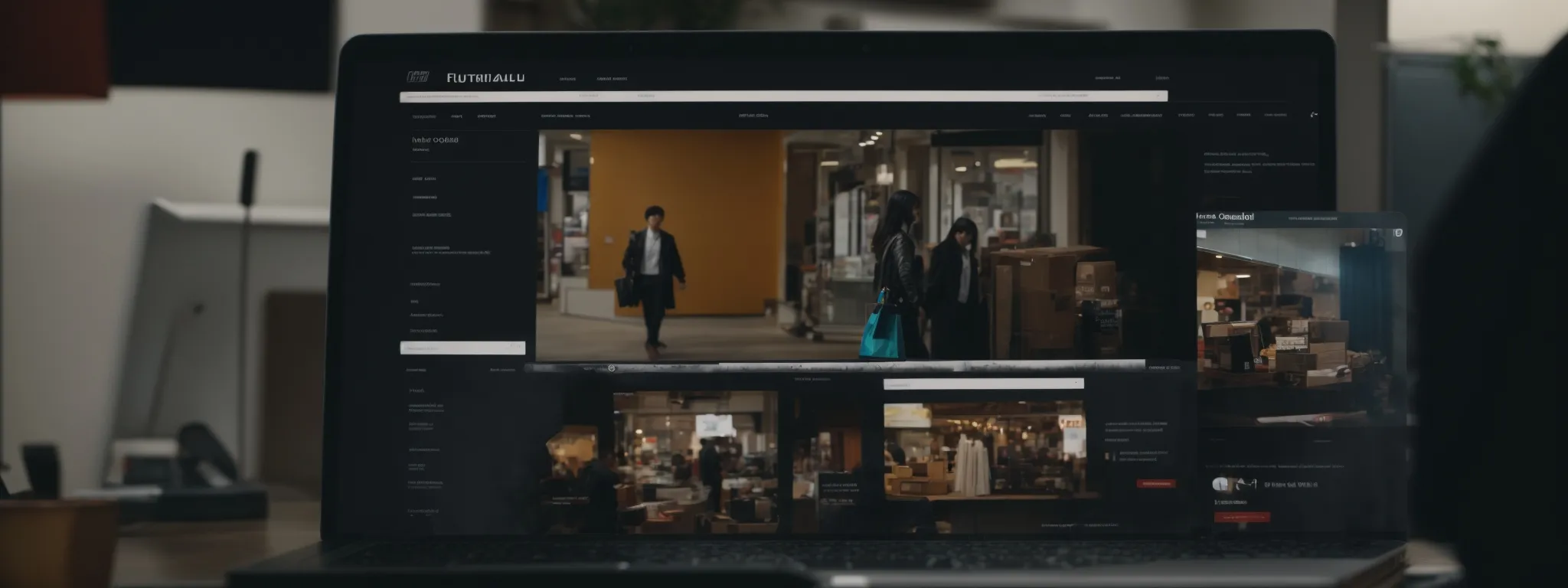Ecommerce SEO Quick Fixes
Effective Ecommerce SEO Quick Fixes for Improved Rankings In the bustling digital marketplace, ecommerce sites must hone their SEO strategy to stay ahead of competitors and capture […]
Effective Ecommerce SEO Quick Fixes for Improved Rankings
In the bustling digital marketplace, ecommerce sites must hone their SEO strategy to stay ahead of competitors and capture the attention of shoppers.
From crafting compelling product descriptions brimming with target keywords to optimizing site speed for a seamless customer experience, the devil is in the detail.
Business owners and ecommerce SEO agencies alike understand that simple tweaks can lead to significant leaps in search engine rankings.
Meticulous attention to meta tags, schema markup, and sitemap can transform an ecommerce platform into a search engine favorite.
Keep reading to uncover practical SEO fixes that can swiftly elevate your ecommerce store’s online presence.
Key Takeaways
- Crafting Unique and Engaging Product Descriptions Is Essential for Improving Ecommerce SEO and Search Engine Rankings
- LinkGraph Employs Strategic Keyword Research and SEO Best Practices to Optimize Product Pages for Visibility and User Experience
- Quick SEO Fixes Like Optimizing Site Speed and Mobile-Friendliness Are Crucial for Improving User Engagement and Search Rankings
- Implementing Schema Markup and Optimizing Meta Tags Can Dramatically Increase Product Visibility in Search Results
- Regularly Updating Blog Content With Strategic Internal Links Is Key to Boosting SEO Effectiveness and Maintaining a Dynamic Ecommerce Platform
Optimize Your Product Descriptions for Search Engines

Within the bustling digital marketplaces of today, the significance of finely honed product descriptions is paramount for an ecommerce platform’s success.
Merchants and business owners frequently overlook this pivotal SEO element, a misstep that hinders their capability to climb the search engine rankings.
As a cornerstone of ecommerce SEO, product descriptions provide more than just basic information; they serve as a strategic touchpoint to captivate potential buyers’ interest and influence conversion rates.
As experts unravel the nuances of search engine optimization, it becomes clear that product descriptions demand meticulous attention.
From discerning the right target keywords that align with shoppers’ search intent to embedding on-page SEO best practices, crafting content that resonates with both search engine algorithms and users is a fine art.
This intricate process involves not only making content engaging and valuable but also ensuring uniqueness, thereby avoiding the trap of duplicate content that can dilute a site’s SEO potency.
Identify Target Keywords for Your Products
In the competitive landscape of ecommerce, pinpointing the correct target keywords is akin to locating the ideal position for your products on a vast, digital shelf.
LinkGraph’s seasoned team employs comprehensive keyword research as part of Their Ecommerce SEO Services, ensuring that each product page is optimized to the tastes and terminologies of its intended audience.
Apply Best Practices for on-Page SEO
Integrating on-page SEO best practices into product pages is not simply advisable; it’s imperative for ecommerce sites intent on augmenting their visibility in search engine results. Attention to detail, from impactful meta descriptions and SEO-friendly URLs to keyword-rich content, plays a critical role in enhancing product visibility.
LinkGraph’s proficiency in honing these integral elements is evident in their Tailored Ecommerce Marketing Solutions. The SEO agency prioritizes an array of on-page factors to bolster their clients’ search rankings:
- Optimized page titles that accurately reflect the product and incorporate the primary search term.
- Engaging product descriptions with strategic keyword placement to appeal to both searchers and search engines.
- Accurate and descriptive alt text for images, ensuring an inclusive user experience for all visitors.
The inclusion of targeted, relevant keywords within product descriptions and titles establishes a strong foundation for reaching the desired audience. LinkGraph stands as a partner to businesses, empowering them with the necessary tools to thrive in the competitive realm of online commerce.
Make Your Content Engaging and Valuable
At the heart of ecommerce success lies the art of sculpting product descriptions that marry user interest with search engine relevance. LinkGraph’s suite of ecommerce SEO services expertly transforms product narratives into persuasive assets, carefully tailored to enhance user experience and drive engagement.
Fusing the science of SEO with the flair of creative writing, LinkGraph helps clients infuse their product pages with informational richness that not only informs but also entertains. This approach ensures that each product page serves as a potent blend of optimized content and magnetic storytelling that captivates both shoppers and search engines alike.
Avoid Duplicate Content Across Listings
In the realm of ecommerce, the blunder of replicating content across product listings can ironically render a site invisible to search engines. LinkGraph addresses this with stringent SEO strategies that emphasize the uniqueness of each product description, ensuring that every item stands out in Google search results, free from the adverse effects of duplicate content.
This ecommerce SEO agency confronts the issue of content redundancy head-on, guiding clients toward creating distinctive narratives for each product. Together with LinkGraph, business owners can boost SEO significantly by eliminating repetitive information across category pages, subcategories, and product pages:
| SEO Element | Common Issues | LinkGraph’s Quick Fixes |
|---|---|---|
| Product Descriptions | Duplicate content in listings | Create unique and engaging copy for each listing |
| Category Pages | Repetitive information | Customize content to cater to specific category themes |
| Product Pages | Identical product details or manufacturer descriptions | Develop original descriptions that highlight unique selling points |
Boost Site Speed for Enhanced User Experience

With the swift evolution of ecommerce platforms, site speed has become a critical component for ensuring a stellar user experience and achieving superior search engine rankings.
Observations reveal a direct correlation between swift page speed and higher conversion rates; thus, to help ecommerce businesses gain an edge, LinkGraph emphasizes quick SEO fixes focused on optimizing website performance.
From compressing images to retain visual quality with reduced file size to leveraging browser caching for quicker load times, minimizing extraneous coding, and selecting high-performance hosting services, LinkGraph lays out a roadmap to streamline the very framework of an ecommerce site.
These enhancements not only heighten user satisfaction but also signal to search engines a commitment to delivering quality, aligning perfectly with the best practices for SEO.
Compress Images Without Losing Quality
LinkGraph’s scalable solutions for ecommerce SEO emphasize the significance of Image Optimization as an often quick SEO fix for augmenting site speed and fostering better user engagement. By reducing image file sizes without compromising visual appeal, ecommerce stores ensure that page load times remain minimal, enhancing the shopper’s journey from landing to checkout.
A noteworthy aspect of optimizing images is the retention of quality, which is essential for displaying products attractively. LinkGraph employs advanced techniques to compress images effectively, maintaining high-resolution visuals that are pivotal for shopper reassurance and conversion.
- Employ lossless compression technology to minimize file sizes without degrading image quality.
- Adopt responsive image solutions that serve appropriately sized images based on the user’s device.
- Implement lazy loading to defer offscreen images, prioritizing immediate viewing content and accelerating page speed.
Leverage Caching for Faster Load Times
Recognizing the pivotal role of site speed in user experience and search rankings, LinkGraph harnesses Caching Techniques to expedite content delivery. By storing static versions of content, such as HTML documents, images, and JavaScript files, caching mitigates server lag, ensuring that ecommerce platforms can display pages with lightning-fast efficiency.
Caching serves as a strategic ally in LinkGraph’s arsenal of optimization tools, allowing for instantaneous page rendering that significantly reduces load times. This approach not only elevates the user’s browsing journey but also bolsters the ecommerce site’s standing in search engine evaluations, making it an indispensable component of a sound SEO Strategy.
Minimize Code and Reduce Server Response Time
Reducing unnecessary code on an ecommerce site directly influences server response times, paving the way for a seamless user experience. LinkGraph’s SEO experts skillfully strip down excessive code and streamline the backend processes, ensuring that every ecommerce store operates with optimal efficiency.
Serving up a web page quickly is key to maintaining engagement and improving search rankings: LinkGraph understands this and works with ecommerce businesses to practice code minimization.
- Assess and remove outdated or redundant scripts.
- Utilize minification techniques on CSS, JavaScript, and HTML.
- Employ Content Delivery Networks (CDNs) to reduce latency.
Choose a Performing Hosting Service
Selecting a high-performing hosting service forms the bedrock of an ecommerce site’s online presence and is a pivotal aspect of LinkGraph’s SEO strategy. A reliable host not only ensures consistent uptimes but also provides the bandwidth and resources necessary to handle the spikes in traffic that a successful SEO campaign can generate.
With LinkGraph’s guidance, clients understand the importance of a hosting solution that delivers fast server response times, which is crucial for both user satisfaction and search engine crawlability. By partnering with a hosting service capable of delivering content swiftly and efficiently, ecommerce businesses position themselves for improved search rankings and amplified search traffic.

The digital marketplace is dynamic, with a constant stream of users navigating through innumerable products and categories.
For an ecommerce business to stand out amidst this online flurry, immaculate site navigation is not just an enhancement, but a necessity.
Simplifying menus, incorporating breadcrumbs, and ensuring mobile-friendliness are more than mere improvements in user interface—they are critical in aiding both users and search engines to understand and value the site.
Internally linking related products enriches shopper experience and bolsters the ecommerce site’s SEO structure.
A streamlined, intuitive navigation system not only pleases visitors but also serves as a silent arbiter, influencing search rankings significantly.
LinkGraph, as a partner to ecommerce businesses, recognizes the potential of well-structured navigation and recommends strategic fixes to ensure that clients’ sites are optimized for navigation efficiency and search engine visibility.
Simplify Your Menu for Easier Navigation
LinkGraph asserts that a well-organized menu is not only about aesthetics; it’s a paramount factor for seamless user navigation and improved search engine discovery. By simplifying the menu structure, ecommerce stores enable customers and search bots alike to traverse their sites with greater ease, consequently enhancing SEO efficiency and user experience.
For an ecommerce platform aiming for superior visibility, the logical arrangement of links and concise categorization within menus is a tactic that LinkGraph advocates. This method streamlines the path to product pages, allowing for quicker access by users and more effective indexing by crawlers, ultimately contributing to better search rankings and a more intuitive shopping experience.
Use Breadcrumbs for Enhanced UX and SEO
LinkGraph emphasizes the deployment of breadcrumbs as an SEO fix that dramatically streamlines site navigation. These navigational aids not only guide users effectively back to previous pages but also optimize the site structure for search engines, ensuring each web page is easily located and indexed.
Breadcrumbs enhance the user journey by displaying a clear trail from the home page to the current page, often including category and subcategory levels:
- Home
- Category Page
- Subcategory Page
- Current Product Page
For search engines, breadcrumbs contribute to SEO by establishing a hierarchy of information and reinforcing keyword relevance. LinkGraph’s ingenious use of breadcrumbs helps create a cohesive framework, assisting search engines in understanding a site’s architecture, and contributing to improved SEO rankings and an enriched user experience.
Internally Link to Related Products
LinkGraph’s ecommerce SEO services underscore the significance of internal linking as a strategic mechanism to foster site authority and cohesion. By connecting related products, an ecommerce site can facilitate a more interactive shopping experience, encouraging users to explore further and stay longer, which in turn can lead to improved search rankings.
This savvy SEO fix creates a network of relevant pathways throughout the ecommerce site, enabling search engines to crawl and index a more expansive array of products with ease. LinkGraph champions this approach, recognizing that well-executed internal links strengthen the overall fabric of an ecommerce store’s SEO framework.
Ensure Your Site Is Mobile-Friendly
Ensuring a website is mobile-friendly has become a fulcrum point for ecommerce success, with a significant portion of online shoppers using mobile devices to browse and purchase. LinkGraph’s client-focused SEO services include a vigilant emphasis on responsive design, guaranteeing that every ecommerce website delivers a flawless browsing experience across all screen sizes and device types.
LinkGraph’s expertise ensures that mobile users encounter no compromise in functionality or content quality, thus amplifying user satisfaction and engagement. A mobile-optimized site is not a mere preference but an SEO imperative, as Google’s indexation now predominantly uses the mobile version of a website:
| SEO Consideration | LinkGraph’s Strategy |
|---|---|
| Responsive Design | Adapt visuals and navigational elements for seamless interaction on mobile devices. |
| Mobile User Experience | Enhance touch elements and streamline site functions to enable easy browsing and transaction on smartphones and tablets. |
A mobile-friendly site reinforces the commitment to reaching a broader audience, as it caters to the searcher on the go. Use of dynamic serving or separate URLs to ensure content equivalence and optimal loading times on mobile devices forms part of the comprehensive strategies that LinkGraph implements to boost SEO and meet users’ expectations.
Update Meta Tags for Improved Click-Through Rates

In the fiercely competitive digital marketplace, employing effective ecommerce SEO quick fixes is crucial for enhancing product visibility and improving rankings.
Meta tags such as titles and descriptions act as critical signposts in search engine results, guiding users towards making that all-important click.
The art of crafting compelling meta titles, infused with carefully selected keywords, lies at the foundation of optimizing click-through rates (CTR).
Accompanying this is the mastery in writing descriptive meta descriptions that succinctly summarize the page content, compelling searchers to engage.
Moreover, the implementation of schema markup amplifies product visibility with the creation of rich snippets, further enticing potential customers.
Together, these elements constitute a triad of micro yet mighty tactics within LinkGraph’s strategic approach to advancing an ecommerce store’s search result standing and captivating a greater audience.
Craft Compelling Meta Titles With Keywords
LinkGraph adeptly identifies the potency of meta titles in the nuanced domain of search engine optimization, recognizing their capacity to serve as decisive beacons in the sea of Google search results. An expertly formulated meta title, replete with the appropriate target keywords, becomes the driving force behind a surge in click-through rates, catapulting a product page to the forefront of shoppers’ consciousness.
In this endeavor, LinkGraph’s strategists meticulously weave target keywords into meta titles, a practice that not only aligns with search term relevance but also appeals to the searcher’s intent. By doing so, they enforce the mettle of the ecommerce store’s web pages to vie for attention against a backdrop of competitors, assuring an uplift in both visibility and engagement within the digital marketplace.
Write Descriptive Meta Descriptions
LinkGraph champions precision and persuasion in meta descriptions, crafting concise summaries that capture a user’s interest and increase the likelihood of a click-through. Their team ensures each meta description is rich with relevant keywords and captures the essence of the product page, effectively signaling value and relevance to users scrolling through search results.
With the deft SEO touch of LinkGraph’s strategists, meta descriptions transition from mere functional text to compelling invitations for users to discover what an ecommerce page has to offer. This attention to detail in meta description creation is a significant but often overlooked quick fix that can enhance a site’s visibility, enticing searchers to make the jump from the search engine to the ecommerce store.
Use Schema Markup for Rich Snippets
In an initiative to heighten product page prominence within search results, LinkGraph harnesses the advanced capabilities of schema markup. This form of structured data marks up website content, enabling search engines to generate rich snippets that offer users snapshot information about products, such as price, availability, and reviews, before they even click through to the web page.
By implementing schema markup, LinkGraph provides its ecommerce clients with a significant competitive edge, effectively increasing organic search visibility and enhancing click-through rates. The strategic use of rich snippets ensures that pertinent product information stands out in search result pages, thereby improving the overall visibility and attractiveness of ecommerce offerings.
Implement or Improve Schema Markup for Visibility

In the quest for digital dominance, employing tactical SEO enhancements serves as a beacon for ecommerce platforms seeking to capture and retain consumer attention.
Scribbling within the intricate lines of search engine algorithms, LinkGraph’s expertise extends to the application of schema markup, a technical but pivotal nuance in the SEO sphere.
By embedding precise schema elements, businesses can significantly sharpen their online visibility.
Delving into product schema augments listing details, while organization schema upholds brand presence and breadcrumbs schema underpins site architecture—each component dovetailed to propel ecommerce sites to the pinnacle of search engine results.
Add Product Schema to Enhance Listings
LinkGraph advocates for the inclusion of product schema to elevate the intricacy and richness of product listings in search engine results. The deployment of this structured data informs search engines of the specific attributes of a product, facilitating the creation of detailed rich snippets that catch the eye of prospective shoppers.
Through the meticulous integration of product schema, LinkGraph ensures that their clients’ ecommerce stores showcase standout listings. Enhanced visibility in search results leads to more informed and engaged users, who are provided with key details such as ratings, prices, and stock availability before they click through.
Use Organization Schema for Brand Consistency
LinkGraph meticulously aligns brand identity across disparate digital channels through the strategic use of organization schema. This structured data type fortifies brand consistency in search engine results, providing a cohesive narrative that seamlessly connects the company’s various online facets.
With an emphasis on maintaining a unified brand appearance, LinkGraph’s application of organization schema acts as an anchor, ensuring that the identity and ethos of an ecommerce business are uniformly presented, thereby reinforcing brand recognition and trustworthiness among searchers.
Implement Breadcrumbs Schema for SEO Structure
LinkGraph underscores the rigor of Breadcrumbs Schema as an integral component in enhancing SEO structure. By outlining a page’s position within the hierarchy of a site, this form of schema markup enables search engines to construct a clearer picture of the site’s layout, driving both indexing efficiency and user navigability.
Incorporating Breadcrumbs Schema, LinkGraph elevates its client’s ecommerce sites, ensuring each web page is effortlessly discoverable and logically interconnected within the digital ecosystem. This SEO tactic not only refines user experience but also solidifies the framework that search engine algorithms utilize to assess and rank web content.
Improve URL Structure for Better Indexing

An intricate fabric of digital pathways, URLs significantly impact an ecommerce site’s ability to be indexed and understood by search engines.
In the bustling online market where every millisecond counts and user ease is paramount, the optimization of URLs becomes an imperative SEO task.
With a focus on enhancing the clarity and efficiency of these vital web addresses, LinkGraph’s array of SEO services to bolster ecommerce platforms includes crafting SEO-friendly URLs laden with relevant keywords, streamlining paths to brevity, and steering clear of convoluted parameters.
For any ecommerce business, these quick SEO fixes wield the power to refine site architecture, boost SEO ranking, and facilitate a smoother user journey.
Use SEO-Friendly URLs With Keywords
In the landscape of digital commerce, the elegance of a URL can be as critical to a product page’s success as the design of the storefront itself. LinkGraph strategists understand that clean, keyword-rich URLs not only impart clarity but also carry weight in the realms of Google search results, driving both search traffic and user navigation with precision.
The expertise of LinkGraph’s SEO team lies in refining the syntax of a URL to ensure that it is both intelligible and optimized for search engines: a carefully chosen, keyword-infused URL becomes a subtle yet potent signal, aligning a web page’s content with the searcher’s quest for specific products or information.
| SEO Element | Why It Matters | LinkGraph’s Optimization Approach |
|---|---|---|
| URL Structure | Key determinant in search engine indexing and user navigation | Streamline and infuse with relevant keywords for better clarity and SEO performance |
| Keyword Integration | Facilitates content relevance and search alignment | Incorporate precise keywords that mirror searcher intent |
Keep URLs Short and Easy to Read
LinkGraph champions the principle that brevity in URL structure plays an essential role in enhancing an ecommerce platform’s searchability. Short URLs, devoid of unnecessary characters and words, impart immediate understanding, offering the dual benefits of memorability for the user and straightforward indexing for search engines.
In the digital ecosystem where clarity is king, LinkGraph’s approach to SEO includes the meticulous distillation of URLs. By paring down lengthy web addresses to their most basic form, this expert SEO agency ensures clients’ ecommerce sites offer a clear, concise path, aiding users in effortless navigation while bolstering SEO ranking potential.
Avoid Complex Parameters and Codes
LinkGraph’s SEO strategy includes purging URLs of convoluted parameters that can confuse both users and search engines. By eliminating unnecessary codes, the SEO agency paves the way for a streamlined, more indexable site structure that resonates with search engine algorithms.
Eliminating complex URL parameters facilitates the search engines’ capability to crawl and understand a web page’s relevance. LinkGraph works relentlessly to ensure that URLs are as simple and navigable as possible, thus enhancing the site’s SEO ranking and user accessibility.
Utilize Alt Tags for Image Optimization

In the realm of ecommerce, images not only captivate but convey vital information, serving as a silent salesman for products.
Optimizing these visual storytellers through alt tags stands as a swift and impactful SEO quick fix, enhancing the accessibility and relevance of an ecommerce website for search engines.
Thoughtfully curating alt text is more than an afterthought—it is a strategic maneuver to infuse images with SEO vigor, as alt descriptions act as whispers to search algorithms, eloquently painting a picture of the product when images are not visible.
By judiciously incorporating keywords and succinct, pertinent descriptions in alt text, an ecommerce platform elevates its user experience and bolsters its position in search engine results.
Add Descriptive Alt Text to All Images
LinkGraph’s meticulous approach to image optimization includes ensuring each visual element on an ecommerce website is accompanied by descriptive alt text. By integrating relevant keywords and clear descriptions within alt tags, this strategic action enables search engines to better interpret the subject matter of images, thus contributing to the site’s SEO performance.
Alt text enriches the user experience, particularly for those reliant on screen readers, while also providing search engines with context to index images appropriately. Through LinkGraph’s seasoned expertise, ecommerce platforms can significantly improve their product’s visibility and accessibility, essentially enhancing search engine rankings and user engagement alike.
Use Keywords Tastefully in Alt Descriptions
Mastering the balance of keyword usage within alt descriptions forms the essence of LinkGraph’s image optimization strategy. It’s a skilled practice that infuses alt tags with relevant keywords without succumbing to keyword stuffing, ensuring both search engine comprehension and user relevance.
Alt tags, when peppered with keywords judiciously, not only elevate a product’s search engine visibility but also enhance the accessibility of an ecommerce store. LinkGraph champions this nuanced approach, effectively turning mere images into robust SEO assets:
| SEO Element | Common Missteps | LinkGraph’s Balanced Approach |
|---|---|---|
| Alt Descriptions | Oversaturation with keywords | Integrate keywords tastefully for optimal search engine relevance and user accessibility |
Keep Alt Text Short and Relevant
LinkGraph stresses the importance of brevity and pertinence when composing alt text for images on an ecommerce site. Concise descriptions facilitate swift comprehension and ensure search engines can promptly associate images with relevant search queries.
Ensuring alt text remains succinct and germane to the content of the image not only complements the user’s navigational experience but also aids search algorithms in accurately classifying the visual content. This relevance is pivotal for ecommerce stores aiming to enhance their product’s search visibility and user accessibility:
| SEO Element | Purpose | LinkGraph’s Best Practice |
|---|---|---|
| Alt Text | Assist search engines and improve accessibility for images | Compose succinct and relevant descriptions to support image content |
Regularly Update Your Blog With Fresh Content

In the digital expanse where content is king, the power of a regularly updated blog cannot be understated for an ecommerce platform seeking improved search rankings.
A content calendar signifies commitment to consistent posting — a critical factor in establishing authority and driving organic search traffic.
Emanating from LinkGraph’s wealth of ecommerce SEO strategies, creating quality blog content emerges as a dedicated effort to answer user queries and introduce a harmonious synergy between entertaining reads and strategic internal links to products.
Engaging, informative, and up-to-date blog posts thus become vital cogs in the machinery of SEO effectiveness, propelling ecommerce sites toward greater prominence in search results.
Plan a Content Calendar for Consistent Posting
Embracing the cadence of a content calendar is a fundamental step for ecommerce stores aiming to maintain a dynamic online presence. LinkGraph assists clients in strategizing content creation, ensuring that consistent posting keeps audiences engaged and search engines attentively indexing fresh material.
Through careful planning and execution of a content calendar, LinkGraph navigates client pathways to attract a loyal following, underpinning the consistent delivery of valuable blog posts that contribute to a steady increase in search visibility and audience retention.
Create Quality Content That Addresses User Queries
LinkGraph recognizes that the bedrock of effective ecommerce SEO lies in crafting content that directly answers the queries of its clientele’s target audience. With precision, they generate blog posts that not only address these questions but also seamlessly lead users towards the relevant products, thereby enhancing search engine visibility and user engagement.
By producing content that elucidates and meets the specific needs of users, LinkGraph positions ecommerce platforms to capitalize on the momentum of organic search. The timely response to audience curiosities cultivates trust and authority, two factors that contribute significantly to improved search rankings for ecommerce sites.
Internally Link to Your Products Within Blog Posts
LinkGraph expertly weaves internal links into blog content, creating seamless pathways that guide readers to product pages without disrupting the narrative flow. This strategy not only harnesses the storytelling power of the blog to showcase products but also strengthens the site’s internal link structure, a critical factor for SEO efficacy.
Encouraging users to explore further, LinkGraph’s integration of internal links within blog posts transforms passive readers into active shoppers. This tactical approach enhances the user experience, while concurrently signaling to search engines the interconnectedness and breadth of content available on the ecommerce platform.
Conclusion
In conclusion, implementing effective ecommerce SEO quick fixes is vital for improving rankings and driving traffic to your online store.
By concentrating on key elements such as optimizing product descriptions with target keywords, applying on-page best practices, ensuring unique content, and boosting site speed, businesses can significantly enhance their search engine visibility.
Furthermore, careful attention to meta tags, URL structures, and alt text for images, along with a strategic approach to site navigation and schema markup, will lead to better indexing and a superior user experience.
Regular updates to blogs with quality content and internal links to products further strengthen an ecommerce platform’s SEO, showcasing the profound impact that these quick but deliberate enhancements can have on an ecommerce site’s competitive edge in search results.















































































